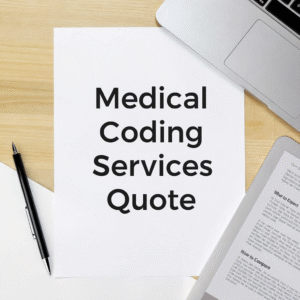The Link Between Coding Accuracy and Patient Satisfaction: A Critical Connection in Modern Healthcare
Coding Accuracy
Coding Accuracy
In the complex ecosystem of modern healthcare, every detail matters. While patients may never directly interact with medical coders or witness the intricate process of translating their medical encounters into standardized codes, the accuracy of this behind-the-scenes work profoundly impacts their entire healthcare experience. The relationship between coding accuracy and patient satisfaction represents one of healthcare’s most underappreciated yet crucial connections, influencing everything from billing transparency to treatment continuity and overall trust in the healthcare system.

Understanding Medical Coding in Healthcare
Medical coding serves as the universal language of healthcare, transforming physician notes, diagnostic procedures, and treatment plans into standardized alphanumeric codes. These codes, primarily using systems like ICD-10 (International Classification of Diseases), CPT (Current Procedural Terminology), and HCPCS (Healthcare Common Procedure Coding System), form the foundation for billing, insurance claims, quality reporting, and clinical research.
Professional medical coders meticulously review patient records, extracting relevant information and assigning appropriate codes that accurately reflect the services provided and conditions treated. This process requires extensive training, ongoing education, and a deep understanding of medical terminology, anatomy, and regulatory requirements. The accuracy of this coding directly impacts multiple aspects of the patient experience, often in ways that patients themselves may not immediately recognize.
The Direct Impact of Coding Accuracy on Patient Financial Experience
Perhaps nowhere is the connection between coding accuracy and patient satisfaction more immediately apparent than in the realm of healthcare billing. Accurate coding ensures that patients receive correct bills that reflect the actual services they received. When coding is precise, insurance claims process smoothly, co-pays and deductibles are calculated correctly, and patients can trust that their financial obligations are fair and accurate.

Conversely, coding errors can create a cascade of billing problems that significantly impact patient satisfaction. Upcoding, where services are coded at a higher level than actually provided, can result in unexpected charges and higher out-of-pocket costs for patients. Downcoding may seem beneficial initially, as it might reduce immediate costs, but it can lead to complications with insurance coverage for future related treatments. Unbundling, where procedures that should be coded together are separated, often results in inflated bills that confuse and frustrate patients.
The financial stress caused by billing errors extends beyond mere inconvenience. Patients may spend hours on phone calls with insurance companies and healthcare providers trying to resolve discrepancies. Some may delay or avoid necessary follow-up care due to confusion about their financial responsibility. Others may lose trust in their healthcare providers, viewing billing errors as evidence of either incompetence or intentional overcharging.
Insurance Processing and Coverage Decisions
Accurate coding plays a pivotal role in insurance claim processing and coverage decisions, directly affecting patient access to care and satisfaction with their healthcare experience. Insurance companies rely heavily on medical codes to determine coverage eligibility, pre-authorization requirements, and reimbursement levels. When coding is accurate, these processes flow smoothly, ensuring patients receive the coverage they expect and deserve.
Coding errors can trigger claim denials, leading to significant delays in treatment approval and increased administrative burden for both patients and providers. Patients may find themselves caught in the middle of disputes between their healthcare providers and insurance companies, required to provide additional documentation or appeal coverage decisions. These situations often result in treatment delays, increased anxiety, and decreased confidence in both the healthcare system and their insurance coverage.

Furthermore, accurate coding ensures that patients’ medical histories are properly documented for insurance purposes. This documentation affects future coverage decisions, pre-existing condition determinations, and eligibility for specialized treatments. Coding errors can create gaps or inaccuracies in these records, potentially impacting a patient’s ability to access care in the future.
Quality of Care Documentation and Continuity
Beyond financial implications, coding accuracy significantly impacts the quality and continuity of patient care. Medical codes become part of a patient’s permanent health record, influencing future treatment decisions and care coordination among multiple providers. Accurate coding ensures that a patient’s complete medical picture is properly documented and communicated across the healthcare system.
When a patient visits a new specialist or receives care at a different facility, medical codes help healthcare providers quickly understand the patient’s medical history, current conditions, and previous treatments. Accurate coding facilitates seamless care transitions and helps prevent medical errors that could arise from incomplete or incorrect information. This continuity of care directly contributes to patient satisfaction by ensuring that each provider has access to comprehensive, accurate information about the patient’s health status.

Inaccurate coding can disrupt this continuity, leading to confusion about a patient’s medical history, missed diagnoses, or inappropriate treatment recommendations. Patients may find themselves repeatedly explaining their medical history or undergoing unnecessary duplicate tests because their records don’t accurately reflect their previous care. These experiences can be frustrating and may compromise the quality of care patients receive.
Population Health and Quality Metrics
Medical coding accuracy also influences broader quality metrics and population health initiatives that ultimately affect patient satisfaction. Healthcare organizations use coded data to track quality indicators, identify areas for improvement, and implement evidence-based care protocols. Accurate coding ensures that these quality improvement efforts are based on reliable data and can effectively address real patient needs.
For individual patients, this means that quality improvement initiatives are more likely to address their specific concerns and improve their care experience. Hospitals and clinics with accurate coding data can better identify patterns in patient satisfaction, clinical outcomes, and care delivery processes, leading to targeted improvements that enhance the overall patient experience.
Inaccurate coding can skew quality metrics, leading to misguided improvement efforts that don’t address patients’ actual needs or concerns. This misallocation of resources and attention can result in continued patient dissatisfaction in areas that aren’t being properly measured or addressed.
Regulatory Compliance and Patient Trust
Healthcare organizations operate under numerous regulatory requirements that depend on accurate medical coding. Compliance with these regulations not only ensures legal operation but also contributes to patient trust and satisfaction. When organizations maintain high coding accuracy standards, they demonstrate their commitment to transparency, accountability, and quality care.
Patients, while they may not understand the technical aspects of coding compliance, often sense when a healthcare organization operates with integrity and attention to detail. Accurate coding reflects an organization’s overall commitment to quality and precision, contributing to patients’ confidence in their care providers. Conversely, coding problems that lead to regulatory issues or billing scandals can significantly damage patient trust and satisfaction.
Technology and Coding Accuracy Improvements
The healthcare industry has increasingly turned to technology solutions to improve coding accuracy and, by extension, patient satisfaction. Computer-assisted coding (CAC) systems, artificial intelligence applications, and electronic health record (EHR) integrations are helping to reduce coding errors and improve consistency. These technological advances benefit patients by reducing billing errors, speeding claim processing, and improving the overall accuracy of their health records.
However, technology is not a panacea. The human element remains crucial in medical coding, as coders must interpret complex medical information and apply their expertise to ensure accurate code assignment. The most effective approaches combine technological tools with skilled human oversight, creating systems that maximize accuracy while maintaining the nuanced understanding that only trained professionals can provide.
Training and Professional Development Impact
The quality of coding accuracy ultimately depends on the skills and knowledge of medical coding professionals. Ongoing training and professional development in the coding field directly benefit patients by ensuring that their medical encounters are accurately documented and processed. Healthcare organizations that invest in coder education and certification see improvements in coding accuracy that translate to better patient experiences.
Professional coders who stay current with coding updates, regulatory changes, and best practices are better equipped to handle complex cases accurately. This expertise helps prevent the coding errors that can lead to patient frustration and dissatisfaction. Organizations that prioritize coding quality often see improvements in patient satisfaction scores, reduced billing complaints, and better overall patient relationships.
Best Practices for Maximizing Patient Satisfaction Through Coding Accuracy
Healthcare organizations can implement several strategies to improve coding accuracy and enhance patient satisfaction. Regular auditing and quality assurance programs help identify and correct coding errors before they impact patients. Clear communication between clinical staff and coders ensures that all relevant information is captured and coded appropriately.

Patient education also plays a role in this process. When patients understand their bills and the coding process, they’re more likely to be satisfied with their healthcare experience, even when complex medical situations result in complicated billing. Transparent communication about charges and insurance processing helps build trust and reduce frustration.
The Future of Coding Accuracy and Patient Experience
As healthcare continues to evolve, the relationship between coding accuracy and patient satisfaction will likely become even more important. Value-based care models increasingly tie reimbursement to patient satisfaction and quality outcomes, making accurate coding essential for financial sustainability. Patients are also becoming more engaged healthcare consumers, expecting transparency and accuracy in all aspects of their care experience.

The integration of artificial intelligence and machine learning in medical coding holds promise for further improving accuracy and reducing errors. However, the human element will remain crucial, as coding requires interpretation of complex medical information and understanding of nuanced clinical situations.
Conclusion
The link between coding accuracy and patient satisfaction represents a fundamental connection in modern healthcare that deserves greater recognition and attention. While patients may never see the codes assigned to their medical encounters, the accuracy of this process profoundly impacts their financial experience, care continuity, and overall trust in the healthcare system.
Healthcare organizations that prioritize coding accuracy demonstrate their commitment to quality, transparency, and patient-centered care. By investing in skilled coding professionals, implementing robust quality assurance processes, and leveraging appropriate technology, these organizations can significantly enhance patient satisfaction while also improving their own operational efficiency and regulatory compliance.
As the healthcare landscape continues to evolve, maintaining high standards for coding accuracy will become increasingly important for organizations seeking to provide exceptional patient experiences. The connection between accurate coding and satisfied patients may operate behind the scenes, but its impact on healthcare quality and patient trust is both profound and enduring. Recognizing and strengthening this connection will be essential for healthcare organizations committed to delivering the highest quality care and the best possible patient experience.



